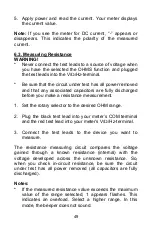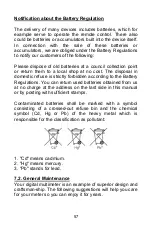
54
1. Set the rotary selector to the diode position.
2. Pl
ug the black test lead into your meter’s COM terminal
and the red test lead into your meter’s V/
/Hz/-
terminal.
3. Connect the test leads to the diode you want to check
and note the meter reading.
Notes:
* If the display shows a value for example 0.2 for a
germanium diode or 0.5 for a silicon diode, reverse the
diode. If the meter indicates and overrange, the diode is
good. The displayed number is the diode’s actual
forward voltage (up to 2.0V).
* If the display indicates an overrange condition, reverse
the polarity of the connection. If the display shows a
value, the device is good. The displayed value is the
component’s actual forward voltage (up to 2.V). If the
display still indicates an overrange condition, the device
is open.
* If the display shows a value both before and after you re-
verse the polarity, the device is shorted.
When you connect the diode to the meter and the meter
displays the devices forward voltage, the red test lead is
connect to the diods’s anode, and the black test lead is
connected to the diode’s cathode. This meter supplies
enough forward voltage to light most LED´s. However, if the
LED’s forward voltage is greater than 2.0 volts, the meter
incorrectly indicates that the device is open.







































